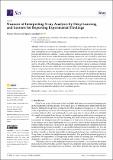Files in this item
Nuances of interpreting X-ray analysis by deep learning and lessons for reporting experimental findings
Item metadata
| dc.contributor.author | Valsson, Steinar | |
| dc.contributor.author | Arandjelović, Ognjen | |
| dc.date.accessioned | 2022-01-18T13:30:01Z | |
| dc.date.available | 2022-01-18T13:30:01Z | |
| dc.date.issued | 2022-01-16 | |
| dc.identifier | 277506427 | |
| dc.identifier | c139f940-02c6-4fd1-97b5-3595bc0eb77d | |
| dc.identifier | 85129555506 | |
| dc.identifier.citation | Valsson , S & Arandjelović , O 2022 , ' Nuances of interpreting X-ray analysis by deep learning and lessons for reporting experimental findings ' , Sci , vol. 4 , no. 1 , 3 . https://doi.org/10.3390/sci4010003 | en |
| dc.identifier.issn | 2413-4155 | |
| dc.identifier.other | Jisc: 2be91bf11ce84d66b39499fee0c24fd5 | |
| dc.identifier.uri | https://hdl.handle.net/10023/24693 | |
| dc.description.abstract | With the increase in the availability of annotated X-ray image data, there has been an accompanying and consequent increase in research on machine-learning-based, and ion particular deep-learning-based, X-ray image analysis. A major problem with this body of work lies in how newly proposed algorithms are evaluated. Usually, comparative analysis is reduced to the presentation of a single metric, often the area under the receiver operating characteristic curve (AUROC), which does not provide much clinical value or insight and thus fails to communicate the applicability of proposed models. In the present paper, we address this limitation of previous work by presenting a thorough analysis of a state-of-the-art learning approach and hence illuminate various weaknesses of similar algorithms in the literature, which have not yet been fully acknowledged and appreciated. Our analysis was performed on the ChestX-ray14 dataset, which has 14 lung disease labels and metainfo such as patient age, gender, and the relative X-ray direction. We examined the diagnostic significance of different metrics used in the literature including those proposed by the International Medical Device Regulators Forum, and present the qualitative assessment of the spatial information learned by the model. We show that models that have very similar AUROCs can exhibit widely differing clinical applicability. As a result, our work demonstrates the importance of detailed reporting and analysis of the performance of machine-learning approaches in this field, which is crucial both for progress in the field and the adoption of such models in practice. | |
| dc.format.extent | 13 | |
| dc.format.extent | 3083931 | |
| dc.language.iso | eng | |
| dc.relation.ispartof | Sci | en |
| dc.subject | Roentgen | en |
| dc.subject | Chest | en |
| dc.subject | Disease | en |
| dc.subject | Thorax | en |
| dc.subject | Error | en |
| dc.subject | Label | en |
| dc.subject | QA76 Computer software | en |
| dc.subject | RC Internal medicine | en |
| dc.subject | DAS | en |
| dc.subject | MCC | en |
| dc.subject.lcc | QA76 | en |
| dc.subject.lcc | RC | en |
| dc.title | Nuances of interpreting X-ray analysis by deep learning and lessons for reporting experimental findings | en |
| dc.type | Journal article | en |
| dc.contributor.institution | University of St Andrews. School of Computer Science | en |
| dc.identifier.doi | 10.3390/sci4010003 | |
| dc.description.status | Peer reviewed | en |
This item appears in the following Collection(s)
Items in the St Andrews Research Repository are protected by copyright, with all rights reserved, unless otherwise indicated.

